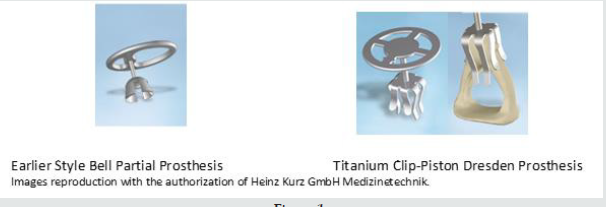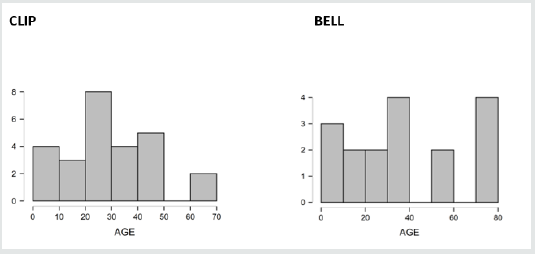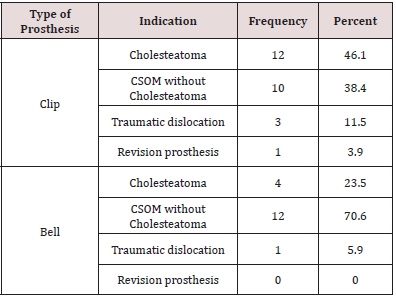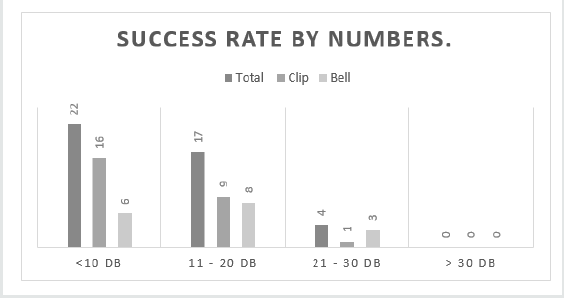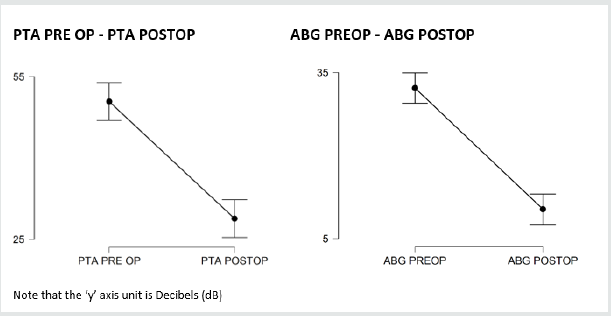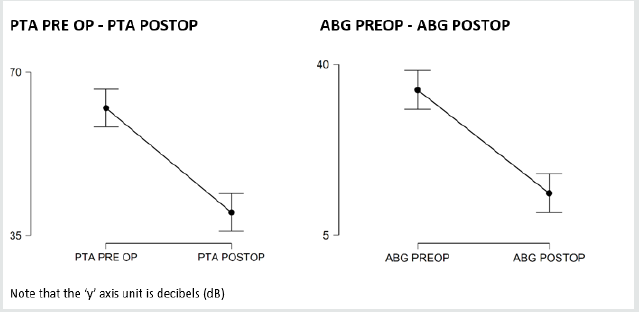
Lupine Publishers Group
Lupine Publishers
Menu
ISSN: 2641-1709
Research Article(ISSN: 2641-1709) 
Audiometric Hearing Results After Ossicular Chain Reconstruction with Partial Titanium Clip Prostheses Volume 5 - Issue 2
Nayellin Reyes Chicuellar1*, Anthony Noor1 and Thomas Kertesz2
- 1Department of Otolaryngology, Royal Darwin Hospital, Australia
- 2Department of Otolaryngology, Prince of Wales Hospital, Australia
Received: August 18, 2020; Published: September 17, 2020
Corresponding author: Nayellin Reyes Chicuellar, Department of Otolaryngology, Royal Darwin Hospital, Northern Territory, Australia
DOI: 10.32474/SJO.2020.05.000207
Abstract
Objective: This paper reviews the outcomes of partial ossicular chain reconstruction using the Kurz Clip-Piston Dresden prosthesis (Clip) in comparison to the earlier generation Bell prosthesis (Bell).
Study design: A retrospective monocentric chart review.
Subjects and Methods: All patients undergoing ossicular chain reconstruction between 1 January 2014 and 31 December 2018.
Results: Forty-three patients, 7 children and 35 adults were included in the study. A successful hearing result was defined as ABG <20 dB [1]. A total of 91% of cases resulted in an overall successful hearing. The overall PTA improved by 20 dB +/- 0.63 (preop: 52.6 +/- 19, postop: 32.6 +/- 14.8). The overall ABG improvement was 33.9 +/- 11.4 (preop: 13 +/- 7.6, postop: 20.7 +/- 3.8). The overall results of Clip being better (96%) than the results for Bell prosthesis (82%). A successful postoperative ABG of <20 dB was obtained in 91% of the patients (n=39). The Clip prosthesis had a significantly higher success rate of 96% (n=26) in comparison to the Bell prosthesis which was successful in 82% of patients (n=14) (p< 0.001). Results showed a low complication rate. One revision procedure (2.3%) to modify the length was needed with a Clip prosthesis and one revision procedure was required in the Bell group due to extrusion; it was replaced with a Clip prosthesis
Conclusion: Clip prosthesis demonstrates promising outcomes partial ossicular chain reconstruction with higher rates of postoperative air-bone Gap reduction and minimal complications.
Keywords: Titanium Clip-Piston Dresden Prosthesis; Old-style Bell Partial Prosthesis; Ossicular Chain Reconstruction; Air-Bone Gap
Abbreviations: Clip: Kurz Clip-Piston Dresden Prosthesis; Bell: Bell prosthesis; PORP: Partial Ossicular Replacement Prosthesis; CSOM: Chronic Suppurative Otitis Media
Introduction
Ossicular chain reconstruction remains the primary method of restoring conductive hearing deficits commonly seen in chronic middle ear disease [2,3]. Since 1994, the German company Kurz has developed different forms of titanium ossicular prostheses. The earlier style Bell prosthesis (Bell) was designed as a partial ossicular replacement prosthesis (PORP) to be placed on the intact stapes capitulum (Figure 1). Design developments led to the newer Clip-Piston Dresden Prosthesis (Clip) which features a springloaded fastening mechanism to secure the coupling to a mobile stapes (Figure 2). The design is reported to reduce dislocation and extrusion of prosthesis with superior audiological outcomes. The purpose of this study is to compare postoperative audiological outcomes and complications of the Clip prosthesis with the Bell prosthesis.
Materials and Methods
Following institutional review board approval (no. 004834UNSW), A de-personalized chart review of all patients who underwent partial ossicular replacement using a Kurz titanium prosthesis from January 2014 to December 2018 was undertaken. All operation was performed by a single surgeon, the senior author (TRK). All the patients had cartilage interposition grafts between the prosthesis and the tympanic membrane. Cohorts were stratified based on the use of either the Kurz Clip-Piston Dresden or the oldstyle Bell Prosthesis. All procedures were analyzed in a postsurgical data base. Pre-operative and post-operative audiograms recorded thresholds at 0.5, 1, 2 and 3 KHz according to AAO-HNS guidelines. All patients completed audiograms 1 week before and three months post-surgery. These results were compared and used for statistical analysis using JASP Statistics Software (Sir Harold Jeffreys’ Statistics Program, University of Amsterdam). Successful reconstruction was determined by a post-operative air-bone gap of 20dB or less [1,4]. A Paired Sample T-test with a Wilcoxon signed rank correction was done for statistical validity.
Results and Analysis
Forty-three patients underwent partial ossicular chain reconstruction during the study period. This cohort comprised both adults and children with ages ranging from 7 to 77 years (Figure 1). Of these 8 were children and 35 were adults. Follow up ranged from 6 months to 3 years with a mean of 22 months. The indications for an Ossicular Chain Reconstruction are summarized in Table 1. The most common indication overall was cholesteatoma followed closely by chronic suppurative otitis media (CSOM) without cholesteatoma.
Overall hearing results
The preoperative and the postoperative audiogram are included in our statistical analyses. The pure tone audiogram (PTA) and the air-bone gap (ABG) included 0.5, 1, 2 and 3 kHz [1,5-7]. The overall hearing thresholds for the PTA and ABG values are shown in Table 2. The overall PTA improved by 20 dB +/- 0.63 (preop: 52.6 +/- 19, postop: 32.6 +/- 14.8), which is statistically significant. The overall ABG improvement was 33.9 +/- 11.4 (preop: 13 +/- 7.6, postop: 20.7 +/- 3.8). There was a very small difference in improvement between the results in Clip and Bell group for PTA (21.6 dB +/- 4.1 vs 22.3 dB +/- 4). A small difference between the results in Clip and Bell groups for ABG (21.8 dB +/- vs 21.2 +/- 0.4 dB) was also noted. Overall, A successful postoperative ABG of <20 dB was obtained in 91% of the patients (n=39) (Table 3 and Figure 2). The Clip prosthesis had a significantly higher success rate of 96% (n=26) in comparison to the Bell prosthesis which was successful in 82% of patients (n=14) (p< 0.001). Furthermore, closure of the ABG to <10dB was achieved in 61% of patients implanted with the Clip prosthesis in contrast to only 36% of those with the Bell prosthesis. A plot diagram of the paired sample T-Test comparing PTA pre and post-surgery and ABG pre and post-surgery comparing Clip and Bell prostheses show that although both prosthesis succeed in improving PTA and ABG post-operatively, the Air Bone Gap is slightly more reduced using the Clip-Piston prosthesis (Figures 3 &4). Repeated measures Anova with a Post Hoc test was used in order to compare the two prostheses. The difference between the two prosthesis was statistically significant (p <0.01). The Clip prosthesis showed a moderate effect size (Cohen’s d= -0.42) when comparing the PTA results (Table 5) and a small effect size (Cohen’s d= -0.25) in comparison of the ABG (Table 6).
Complications
One patient in the Clip prosthesis cohort required a revision procedure due to the inadequate length of the prosthesis. This was replaced by a longer prosthesis without complication. No patients experienced extrusion of their prostheses or sensorineural hearing loss. One revision OCR in the Bell cohort was needed as it extruded, subsequently it was replaced with a Clip prosthesis. No patients experienced sensorineural hearing loss.
Discussion
The titanium Clip has been designed to improve operative
and hearing outcomes over previous generation of prostheses
developed for ossicular chain reconstruction [8]. With flexible feet
at the base of the prosthesis, a secure coupling can be achieved with
the stapes capitulum with ease of application leading to reduced
displacement and improved sound conduction [9-11]. This study
aimed to evaluate the audiological outcomes and safety profile of
this prosthesis and compare this to the earlier Bell prosthesis.
Our overall results demonstrate a significant improvement in
hearing outcomes with both prostheses. The average improvements
in the ABG for the Clip and Bell prosthesis were 21.8dB and 21.2dB,
respectively. Similarly, favorable outcomes have also been reported
in the literature. In their study of 130 patients receiving the Clip
prosthesis, Kahue et al. [12] observed a reduction in the median
ABG and PTA of 11dB in comparison to preoperative values.
Similarly, Gostian et al. [13] demonstrated stable hearing outcomes
in their long-term study (6.5 years) where a reduction in ABG of
8.9dB was seen. In our cohort of patients receiving using the Clip
prosthesis, successful ossicular reconstruction, defined as an
ABG of 20dB or less, was achieved in 91% of patients. This was a
significant improvement over the Bell prosthesis which exhibited
a success rate of 82%. Furthermore, an ABG of 10dB or less was
achieved in 61% of patients in the Clip versus just 36% of those in
the Bell cohort. The superiority of these outcomes is substantiated
by the previously mentioned authors where success rates of 72%
[13] and 63% [12] were achieved using the Clips prosthesis.
We that found that one patient experienced extrusion of the
Bell prosthesis despite the use of cartilage interposition grafts. No
such cases were experienced with the Clip prosthesis however one
revision was required with this device due to inadequate length
and persistent hearing loss. The Clip prosthesis was able to be
replaced without any undue force on the stapes or subsequent
complications. These low rates of displacement/extrusion compare
far more favorable that those reported with earlier generation
prostheses which have demonstrated displacement in up to 7.7%
of cases [14]. This is likely the consequence of the clip design
optimizing adherence to the stapes superstructure. The design also
requires a small amount of force to engage the clip onto the stapes
capitulum. In our study, this did not result in disruption of the
stapes or sensorineural hearing loss in any of our patients which
supports the safety profile of its application. Indeed, in the two
compared studies no significant events were reported as a result
of the surgery and a minor extrusion rate of 1.5% in patients which
was seen in the setting of recurrent middle ear disease [12]. Several
limitations can be described in this study. The retrospective nature
of this investigation lends itself to inherent selection bias. This in
addition to the small cohort size may influence the significance of
the statistical analysis. With further recruitment and longer term
follow up more definitive conclusions can be drawn and provide
opportunity for subgroup analysis.
Conclusion
Partial ossicular chain reconstruction using the titanium Clip prosthesis provides excellent audiological outcomes superior to those seen with the earlier generation Bell prosthesis. Successful hearing restoration was seen in 91% of patients with a favorable safety profile. No cases of displacement, extrusion or sensorineural hearing loss were encountered.
References
- Monsell MBTA, Gates GA, Goldenberg RA, Meyerhoff WL, House JW (1995) Committee on Hearing and Equilibrium guidelines for the evaluation of results of treatment of conductive hearing loss. Otolaryngol Head Neck Surg 113(3): 186-187.
- Statistics ABO (1993) Disability, Ageing and Cares. Hearing Impairment.
- Hogan A, Shipley M, Strazdins L (2001) Communication and behavioral disorders among children with hearing loss increased risk of mental health disorders. . Australian & NZ Journal of Public Health 35(4): 377-383.
- Shah KD, Bradoo RA, Joshi AA, Sapkale DD (2013) The efficiency of titanium middle ear prosthesis in ossicular chain reconstruction: our experience. Indian J Otolaryngol Head Neck Surg 65(4): 298-301.
- Haberman RS, Salapatas AM (2018) Hearing Outcomes after Ossicular Reconstruction with Removal of the Malleus. Otolaryngol Head Neck Surg 158(1): 144-150.
- Roth JA, Pandit SR, Soma M, Kertesz TR (2009) Ossicular chain reconstruction with a titanium prosthesis. J Laryngol Otol 123(10): 1082-1086.
- Vassbotn FS, Moller P, Silvola J (2007) Short-term results using Kurz titanium ossicular implants. Eur Arch Otorhinolaryngol 264(1): 21-25.
- Gottlieb PK, Li X, Monfared A, Blevins N, Puria S (2016) First results of a novel adjustable length ossicular reconstruction prosthesis in temporal bones. Laryngoscope 126(11): 2559-2564.
- Mao M, Zhai J, Chen G, Zhang J, Ma Z, Xue J (2014) Effect of ossicular chain reconstruction with titanium ossicular replacement prosthesis in mastoidectomy with synchronous ossiculoplasty. Lin Chung Er Bi Yan Hou Tou Jing Wai Ke Za Zhi 28(10): 708-711.
- Goode RL, Nishihara S (1994) Experimental models of ossiculoplasty. Otolaryngol Clin North Am 27(4): 663-675.
- Birk S, Brase C, Hornung J (2014) Experience with the use of a partial ossicular replacement prosthesis with a ball-and-socket joint between the plate and the shaft. Otol Neurotol 35(7): 1248-1250.
- Kahue CN, O Connnell BP, Dedmon MM, Haynes DS, Rivas A (2018) Short and Long-Term Outcomes of Titanium Clip Ossiculoplasty. Otol Neurotol 39(6): e453-e460.
- Gostian AO, Kouame JM, Bremke M, Ortmann M, Huttenbrink KB, et al. (2016) Long term results of the titanium clip prosthesis. Eur Arch Otorhinolaryngol 273(12): 4257-4266.
- Hillman TA, Shelton C (2003) Ossicular chain reconstruction: titanium versus plastipore. Laryngoscope 113(10): 1731-1735.

Top Editors
-

Mark E Smith
Bio chemistry
University of Texas Medical Branch, USA -

Lawrence A Presley
Department of Criminal Justice
Liberty University, USA -

Thomas W Miller
Department of Psychiatry
University of Kentucky, USA -

Gjumrakch Aliev
Department of Medicine
Gally International Biomedical Research & Consulting LLC, USA -

Christopher Bryant
Department of Urbanisation and Agricultural
Montreal university, USA -

Robert William Frare
Oral & Maxillofacial Pathology
New York University, USA -

Rudolph Modesto Navari
Gastroenterology and Hepatology
University of Alabama, UK -

Andrew Hague
Department of Medicine
Universities of Bradford, UK -

George Gregory Buttigieg
Maltese College of Obstetrics and Gynaecology, Europe -

Chen-Hsiung Yeh
Oncology
Circulogene Theranostics, England -
.png)
Emilio Bucio-Carrillo
Radiation Chemistry
National University of Mexico, USA -
.jpg)
Casey J Grenier
Analytical Chemistry
Wentworth Institute of Technology, USA -
Hany Atalah
Minimally Invasive Surgery
Mercer University school of Medicine, USA -

Abu-Hussein Muhamad
Pediatric Dentistry
University of Athens , Greece

The annual scholar awards from Lupine Publishers honor a selected number Read More...




